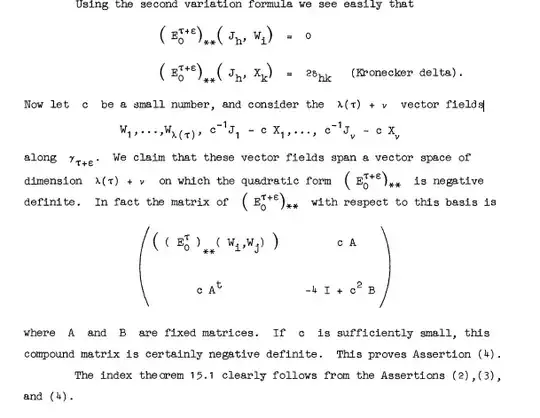Here is a clipping from Milnor's Morse Theory. Since this question about linear algebra, I will present my question below so that no prior knowledge of the materials in the book required to answer this question.
The only relevant thing here is the matrix of size $(\lambda+v)^2$ at the bottom. Here $\Big((E^{\tau}_0)_{**}(W_i,W_j)\Big)$ is a negative definite matrix of size $\lambda^2$ and for convenient, let's call this matrix $M$. The $(\lambda+v)^2$-matrix become $$ H_c= \begin{pmatrix} M & cA\\\ cA^t & -4I+c^2B \end{pmatrix} $$ where $A$ and $B$ are some fixed matrix of size $\lambda \times \nu$ and $v^2$ respectively, $M$ is a negative definite matrix of size $\lambda^2$, and $c$ is an arbitrary real number.
Now the claim is that we can pick $c$ such that $H_c$ is a negative definite matrix. I.e., there is $c$ such that for any $x \neq 0$, $x^tH_cx <0$. I've tried this by writting $x = (a \quad b)^t$ where $a$ and $b$ are column vectors of lenght $\lambda$ and $\nu$ respectively and then do the block matrix multiplication $$ \begin{pmatrix} a & b \end{pmatrix}^t H_c \begin{pmatrix} a \\ b \end{pmatrix} $$ and see if i can adjust $c$ to make the whole expression negative no matter how big or small $a$ and $b$ are. But i think it's messy and i want a clean or general way to get the result. I hope somebody could help me with this. Thank you.
